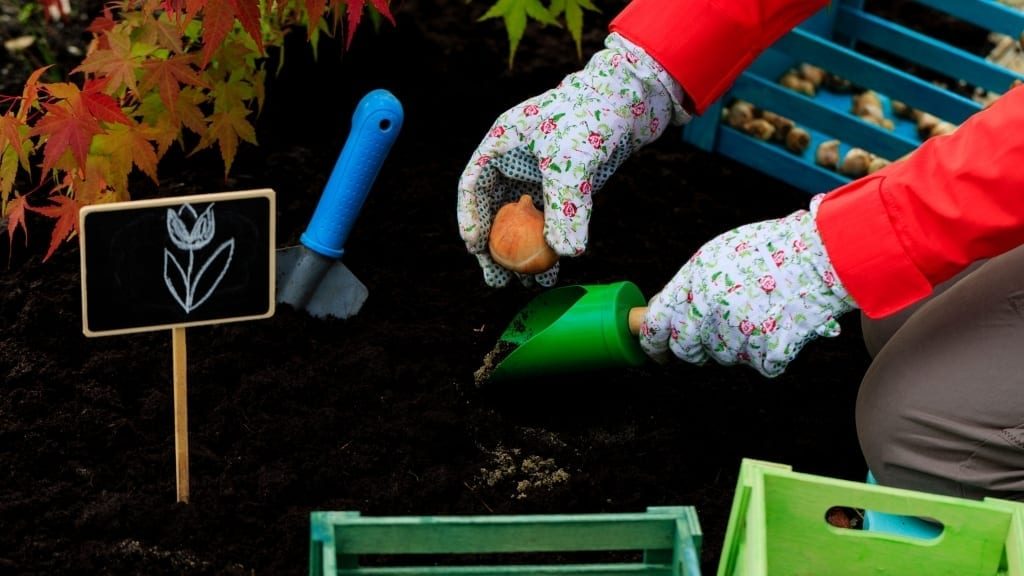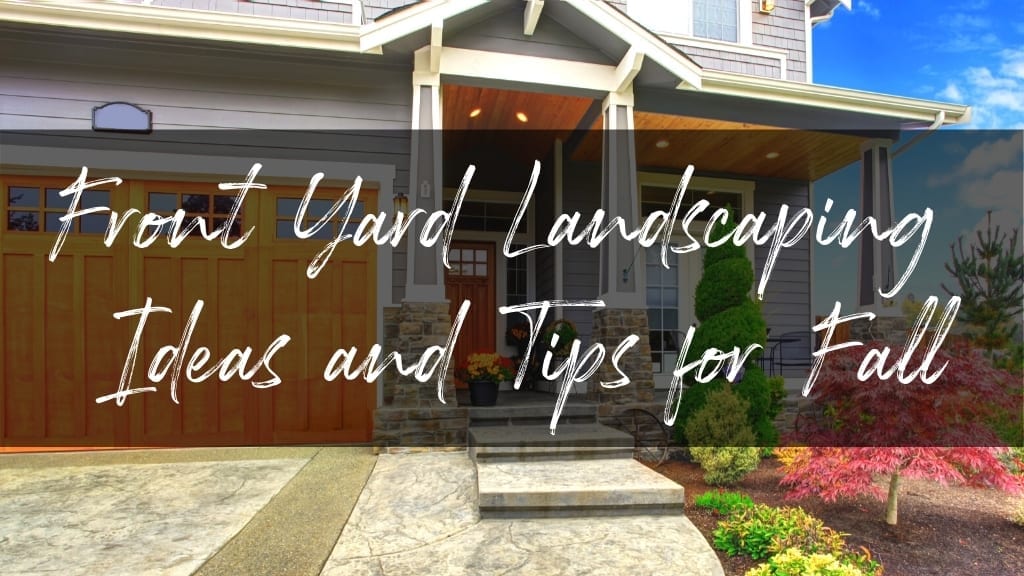Landscaping your front yard can be something you debate about for years. Because your front yard is on display for the neighborhood, there can be some strong feelings associated with this space.
We’ll provide some fall design ideas to inspire your front yard landscaping project. Many of these examples are great DIY projects that could be accomplished in a single weekend. Then, we’ll cover some common initial questions when considering front yard landscaping. These questions or uncertainties are easy to overcome when armed with the right knowledge.
Front Yard Landscaping Inspiration for Fall

Add Perennial Color to Your Front Yard Flowerbeds
Think about which colors will pair well with your home exterior. In this example, the rust-colored sedum (stonecrop), yellow rudbeckia (black-eyed susans), and annual purple fountain grasses offer a pleasing array of fall color. And, the grey stone of the house exterior provides a beautiful backdrop where these colors can shine. Also, these perennials are pretty low-maintenance after being planted. They pair well with the larger and perhaps more established elements like the golden-leafed maple tree (right) and limey elderberry shrub’s leaves (left). The heuchera (coral bells) at the front of the planting bed offers a bright foliar pop of magenta that pairs well with planting colors across the seasons.

Add Formality With Symmetry or Repetition
Plantings don’t need to be diverse to make an impact in your front yard landscape. In this example, the path to the front entry is flanked by burning bushes, evergreens like a globe arborvitae, y low-growing junipers. The same effect could be achieved by repeating the globe arborvitae and junipers as a hedge laterally in the front of the house.

Create A Focal Point With Front Door Fall Planters
Don’t underestimate the power of planters to add curb appeal. Planters offer an opportunity to reflect the style and scale of your home. They’re available in all shapes and sizes and can add a pop of color to draw the eye to your front entrance. And the styling options are nearly endless with fall planters. They can combine live plantings with artificial to provide color and interest until frost. And, if you change your mind in a few weeks? It’s easy to update your container with a new color scheme or adjust texture to fit with from yard landscaping evolutions.
Get the latest fall decor tips here.

Give Your Front Yard Entry Path A Facelift
If your concrete path to the front door has seen decades of salt in winter and blazing heat in summer, it may show serious wear and tear. It may be time for an upgrade, like this stone pathway. You may also want to consider a more welcoming or interesting path to your front door and add lawn lights to illuminate your new entry. Adding planting space next to the front path can also provide a more welcoming entrance. For those with small yards, adding flowerbeds next to the front path can add new space for fall color where there wasn’t room previously.

Add Interest in the Corners
Install a small picket fence segment in the corner of your front yard property to add definition and increase your planting space. Simply dig down to set your fence posts. Then, attach fence paneling. Paint the posts and pickets a neutral color to provide a clean planting backdrop. Then, choose your perennial plantings to add a pop of color for passersby. Here, we see rudbeckia (black-eyed Susans) mass-planted for a beautiful yellow display that works well in fall front yards.

Add A Focal Point With A Water Feature
Water features can be extremely easy to install when using a self-contained trickling water fountain. A water feature in a front yard garden bed can provide a focal point that isn’t the front door. This can add interest and may help balance a yard that has an asymmetrical layout. Additionally, water features can add height to a planting space that may otherwise be filled with mid-height or lower plantings.

Plant Bulbs in Front Yard Flowerbeds
What better way to ensure your curb appeal makes an impact every season than planting bulbs? Fall is the perfect time to plan ahead for next year’s garden. Bulbs are the first glimmers of color we see peeking out of the ground after a long, gray winter.
Here are just a few varieties you might try:
- Alliums
- Crocus
- Daffodils
- Hyacinths
- Scilla (includes Bluebells)
- Tulips
Get more tips on bulb planting by stopping into your local garden center/nursery.
Common Front Yard Landscaping Questions
Can I DIY my front yard landscaping?
-
your physical ability
-
the project complexity
-
your availability and time to complete the project
-
and budget.
What is the definition of hardscaping and softscaping in landscape design?
-
gravel pathways
-
concrete or stone sidewalks
- boulders and natural stone
-
patios
-
decks
-
pergolas
-
and arbors.
To develop a balanced landscape, you’ll often want to have both hardscape and softscape elements in your yard. Some hardscape elements might already be there for you. For example, in your front yard you may have a front porch or entryway space. In order to access your front door, you may have steps leading up to the entryway or porch. Then, you may have a sidewalk from the driveway that leads to those steps indoors. If you want to change any of these elements, you’ll need to plan for hardscaping.
How do I hide unattractive elements in my front yard?
-
telephone poles
-
sewer cleanout access
-
utility meters
-
a well cap
-
or a septic access panel.
Platt Hill Nursery is Chicago’s premier garden center and nursery.



